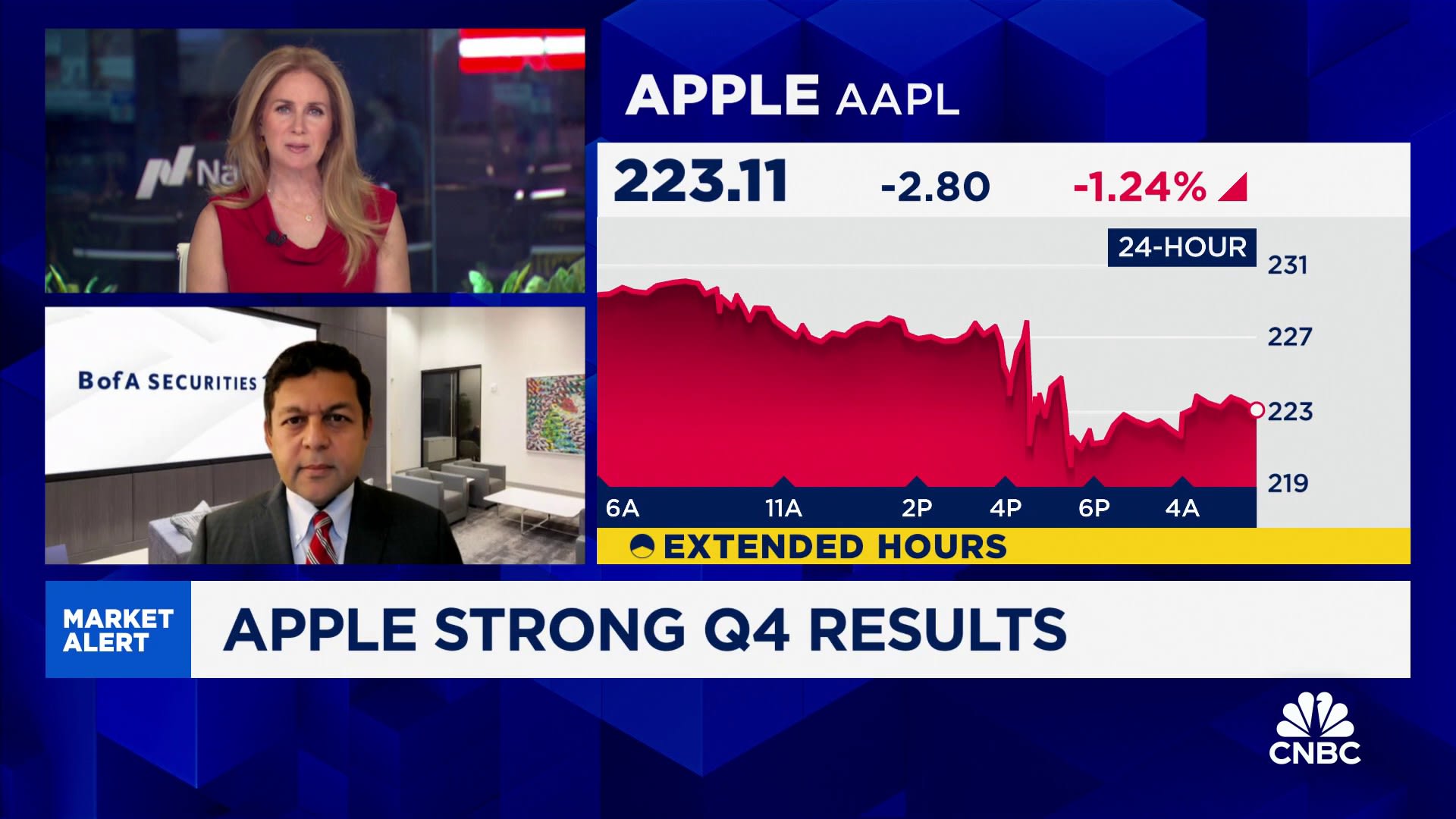A series of iPhone 16s on display inside the Apple store at Tun Razak Exchange in Kuala Lumpur, Malaysia, on Sept. 20, 2024.
Annice Lyn | Getty Images News | Getty Images
One of the first things Steve Jobs did when he returned to Apple in 1997 was simplify Apple’s product lineup. At the time that meant four computers: Two laptops and two desktops, each in a pro and consumer version.
“If we had four great products, that’s all we need,” Jobs said at a product launch in 1998.
Three decades later, Apple’s product lineup is much broader. The company in 2024 launched four iPads, four MacBooks, two desktop Macs, one Vision Pro headset, two Apple Watch models and three kinds of AirPods. But when it comes to iPhones, four remains the magic number.
That’s how many iPhones the company has released each year since 2020, and in September, it released the iPhone 16, the iPhone 16 Plus, the iPhone 16 Pro and the iPhone 16 Pro Max.
Apple introduced the four-phone lineup because historically the company’s iPhone sales have seen the strongest growth when it expanded the lineup. If Apple can show growth from the four new phones it releases each year without them cannibalizing one another, that gives the company its best chance to see iPhone sales grow meaningfully for the first time since 2022.
The company doesn’t give sales figures for its individual products, and overall iPhone sales for fiscal 2024 came in at $201.18 billion. That’s relatively flat going back to 2022.
Unfortunately for Jobs’ company, not all of the iPhones are equally popular.
Every year since 2020, one of the new iPhone models has lagged its siblings in sales. This year it’s the iPhone 16 Plus, which lands in the middle of the lineup. At $899 in the U.S., it’s more expensive than the baseline iPhone 16 but cheaper than the iPhone 16 Pro and Pro Max, which have better screens.
DSCC, a research firm focused on the smartphone display industry with estimates derived from the panel supply chain, has picked up on this trend. The shares of the Pro and Pro Max phones have been rising on an annual basis while the Plus model declined from about 21% of total Apple screen orders in 2022 to 10% in 2023, according to DSCC’s data for annual panel procurement through October. While it recovered somewhat to 16% this year, it’s still the lowest volume out of the company’s new iPhones, according to DSCC.
“They’re still really struggling with this fourth model,” DSCC founder Ross Young said.
Other data shows the Plus lagging, too. The iPhone 16 Plus accounted for 4% of overall iPhone sales in the U.S. in the third quarter while both the Pro and Pro Max each accounted for 6% of sales, according to survey findings by Consumer Intelligence Research Partners. The regular 16 accounted for 4%, too, although early cycle iPhone sales are heavily weighted toward early adopters and the Pro models, according to CIRP.
The metric only includes a few weeks of the latest model sales in the third quarter, but the 2024 findings are in line with last year’s, where the 15 Plus accounted for 3% of total sales about a month after launch.
Apple’s iPhone 15, iPhone 15 Pro and iPhone 15 Pro Max took the top three spots, respectively, in Counterpoint’s data for the best-selling individual smartphone models around the world in the third quarter of 2024. The Plus model didn’t make the top 10 list.
The Mini and Plus failures
Apple’s Series 16 iPhones are seen on display at the Apple Store, Regent Street on September 20, 2024 in London, England.
Peter Nicholls | Getty Images News | Getty Images
When the iPhone was introduced in 2007 there was one new model per year. The lineup has expanded quite a bit since then, while Apple keeps older models on store shelves as budget options.
In 2014, Apple introduced the iPhone 6 Plus, the first time iPhone came in two sizes, which led to three straight quarters of growth of over 27% in 2015. After Apple released the iPhone X in 2017, raising the price of the highest-end phone and creating a three-model lineup, the company saw three straight quarters of growth of more than 15%.
After Apple moved to a four-phone lineup in 2020, growth surged, hitting 54% in one quarter, although that was partially boosted by the pandemic. But since then, iPhone sales have been basically flat.
When the company introduced the iPhone Mini in 2020, it was the lowest-cost new iPhone at the time, at $699.
Apple kept the same strategy in place in 2021, hoping that the vocal minority of consumers that had previously demanded smaller phones would flock to the device. It didn’t work, and Apple no longer sells a device with a 5.4-inch screen.
By 2022, Apple shifted its approach and introduced the iPhone 14 Plus, which had the same chip and features as the company’s entry level iPhone 14 but a larger screen. That mirrored Apple’s successful strategy from 2014. Apple boosted its panel procurement for the iPhone 14 Plus up to 21% of the total screens it ordered that cycle, according to DSCC.
But the Plus strategy didn’t work as well as it had before.
Is Air next?
The new iPhone 16 Pro model is available at an Apple store in Bangkok, Thailand, on September 20, 2024. Apple now makes available to consumers its new lineup of iPhone 16 models, which are the iPhone 16, Plus, Pro, and Pro Max.
Anusak Laowilas | Nurphoto | Getty Images
Looking ahead, Apple is keeping its four iPhones strategy in place, but it may change the approach it takes to finding a successful fourth model for its 2025 lineup.
Instead of a fourth Mini model at the low end of the lineup or a Plus in the middle, Apple may introduce an Air model at the top of the lineup. An Air offering could be distinguished by a lighter-weight device and a higher starting price, according to an August report by Bloomberg News.
Despite giving it a higher price tag, Apple may have to make a trade-off on the Air device by limiting it to one camera, due to the lighter weight and a slimmer design. Apple’s current high-end phones, the Pro and Pro Max, have three big cameras that add photographic capabilities but also add weight. DSCC’s Young said he expects the screen size of the Air to come in at 6.55 inches, between this year’s Pro and Pro Max sizes.
A new high-end phone could make sense for Apple. In recent years, the Max models have outperformed the lower-end models in sales, suggesting there is stronger demand for more powerful and feature-packed phones at the top of Apple’s lineup than there is for lower-cost models.
In October, Apple signaled that the company had enough stock of the iPhone 16 and iPhone 16 Plus to meet demand but that the more expensive Pro and Pro Max were still in short supply.
Outside the U.S., Apple’s more expensive models have shown more growth in recent years. In the first three weeks of iPhone 16 sales in China, the 16 Pro and Pro Max models were up 44% compared with last year’s high-end models.
Model preferences also vary across regions, Counterpoint analyst Varun Mishra told CNBC.
“In China, the Pro series is performing well, as consumers there tend to favour the Pro models,” Mishra said in an email. “In India, the Pro series is strong, partly due to a lower launch price compared to last year, thanks to local manufacturing.”
Apple has previously released thinner, lighter models of its existing products in order to raise prices and push the limits of its engineering. In 2008, Apple introduced the MacBook Air, which it marketed by saying that it was thin enough to fit in an envelope. At first, it was more expensive than Apple’s other Macs, starting at $1,799, but over the years, MacBook Air has become Apple’s entry-level laptop.
In 2013, the company did the same thing with its iPad, introducing an iPad Air, with a thinner design, although it was Apple’s flagship new iPad model released that year. Apple now uses the iPad Air as the middle option in its iPad lineup.
For Apple, a shift from Plus to Air could mean more iPhone sales, especially if the new model is priced higher than the other iPhones, which could help Apple expand its margin and continue the recent trend of a higher average iPhone selling price. It could also help focus Apple’s early adopters and fans on one single high-end iPhone model.
“Next year they’re going to try something different,” Young said.
WATCH: The iPhone 16 upgrade can be a multiyear cycle, says BofA’s Wamsi Mohan

EMEA Tribune is not involved in this news article, it is taken from our partners and or from the News Agencies. Copyright and Credit go to the News Agencies, email news@emeatribune.com Follow our WhatsApp verified Channel





